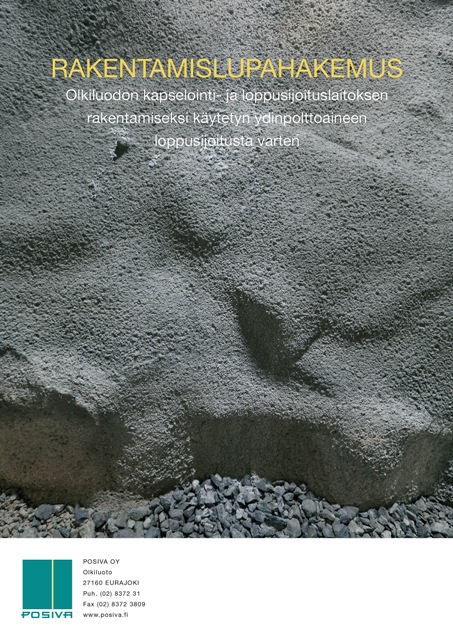Posiva submits Construction Licence Application For Final Repository to the Government
Posiva submitted its Construction Licence Application for a Final Repository for Spent Nuclear Fuel to the Government on 28 December 2012.


The repository to be built in Olkiluoto, Eurajoki, has been designed for the final disposal of spent nuclear fuel from the nuclear power plants operated by Posiva's owners, TVO and Fortum. A total of 9,000 tonnes of uranium fuel will be disposed of from the four existing plant units, Olkiluoto 3 currently under construction, and Olkiluoto 4 that is being planned.
"The construction licence application is based on more than 30 years of research and development work, carried out ever since the commissioning of the existing nuclear power plants. The data gathered over the decades has confirmed our views of the safety of geologic disposal," says Reijo Sundell, the President of Posiva.
The application for a construction licence concerns a complex of two interconnected nuclear facilities, an above-ground encapsulation plant and an underground final repository. The complex also includes facilities intended for the final disposal of nuclear waste created during the operation and decommissioning of the encapsulation plant. The final repository will be built at a depth of 400–450 metres. The repository will consist of a tunnel network, to be built in stages, and the related technical facilities.
The suitability of the Olkiluoto bedrock for the final disposal of nuclear waste has been confirmed with the construction of the underground characterization facility ONKALO. The data gathered through surveys carried out in ONKALO and above ground have been used to develop the criteria and detailed procedures for locating the final disposal tunnels in the Olkiluoto bedrock in a manner that best guarantees the optimal utilisation of the bedrock's characteristics favourable for long-term safety. "We will use a rock suitability classification and excavate the disposal facilities into solid rock in stages during the planned 100 years of operation," says Executive Vice President Timo Äikäs.
The long-term safety of final disposal is, above all, based on carefully studied, complementary engineered barriers that have been tested in practical experiments. The engineered barriers include a tight final disposal canister capable of withstanding corrosion, the bentonite clay buffer that decouples the canister from the bedrock, the tunnel backfill and the plugging system. The bedrock itself also functions as a barrier when necessary.
The fulfilment of the long-term safety requirements is discussed in the safety case prepared for the licence application, submitted to the Radiation and Nuclear Safety Authority for appraisal. According to the safety case, the annual radiation doses incurred as a result of the likely developments within the next ten thousand years would remain considerably below the maximum allowable doses even for the persons with the highest exposure. "Even in the unlikely case that several canisters break at the same time, the releases of radioactive substances would remain at one tenth of the limits set by the Radiation and Nuclear Safety Authority at the most," says Juhani Vira, Posiva's Senior Vice President for Research.
During the processing of the construction licence application, Posiva will prepare its organization for the launch of the encapsulation plant and final repository projects. Full-scale testing of final disposal technology will also begin in ONKALO. "We will test the installation of engineered barriers at the final disposal depth," explains President Reijo Sundell.
Share